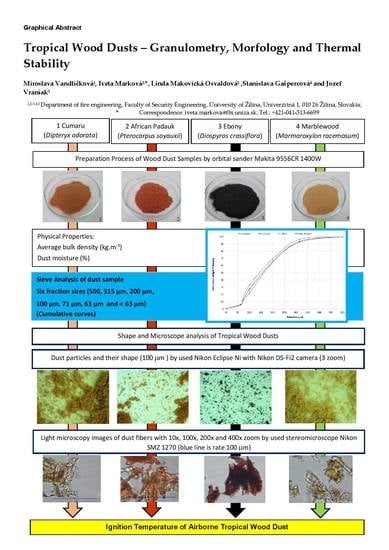Tropical Wood Dusts—Granulometry, Morfology and Ignition Temperature
Abstract
:1. Introduction
2. Sample Materials and Methods
2.1. Samples—Tropical Woods
2.2. Preparation of Tropical Wood Dust Samples
2.3. Experimental Methods Utilised for Characteristics of Tropical Wood Dusts and Sieve Analysis
2.4. Experimental Methods for Shape of Wood Dust Particles
2.5. Experimentation So as to Determine the Ignition Temperature Measurement of Airborne Dusts
3. Results and Discussion
3.1. Results of Particle Sizes (Fractions) of Dust Samples
3.2. Shape Analysis of Dust Particles
3.3. Microscopic Dust Analysis
3.4. Ignition Temperature of Airborne Dust
4. Conclusions
Author Contributions
Funding
Acknowledgments
Conflicts of Interest
References
- Top, Y. Relationship between Employees’ Perception of Airborne Wood Dust and Ventilation Applications in Micro-Scale Enterprises Producing Furniture. BioRes 2020, 15, 1252–1264. [Google Scholar]
- Očkajová, A.; Beljo Lučić, R.; Čavlović, A.; Tereňová, J. Reduction of dustiness in sawing wood by universal circular saw. Drv. Ind. 2006, 57, 119–126. [Google Scholar]
- Ockajova, A.; Beljakova, A.; Luptakova, J. Selected properties of spruce dust generated from sanding operations. Drv. Ind. 2008, 59, 3–10. [Google Scholar]
- Piernik, M.; Rogozinski, T.; Krauss, A.; Pinkowski, G. The influence of the thermal modification of pine (Pinus sylvestris L.) wood on the creation of fine dust particles in plane milling Fine dust creation in the plane milling of thermally modified pine wood. J. Occup. Health 2019, 61, 481–488. [Google Scholar] [CrossRef] [PubMed] [Green Version]
- Očkajová, A.; Kučerka, M.; Kminiak, R.; Krišťák, L.; Igaz, R.; Réh, R. Occupational Exposure to Dust Produced When Milling Thermally Modified Wood. Int. J. Environ. Res. Public Health 2020, 17, 1478. [Google Scholar] [CrossRef] [PubMed] [Green Version]
- Očkajová, A.; Barcík, Š.; Kučerka, M.; Koleda, P.; Korčok, M.; Vyhnáliková, Z. Wood dust granular analysis in the sanding process of thermally modified wood versus its density. BioRes 2019, 14, 8559–8572. [Google Scholar]
- Igaz, R.; Kminiak, R.; Kristak, L.; Nemec, M.; Gergel, T. Methodology of Temperature Monitoring in the Process of CNC Machining of Solid Wood. Sustainability 2019, 11, 95. [Google Scholar] [CrossRef] [Green Version]
- Li, H.T.; Chen, X.K.; Deng, J.; Shu, C.M.; Kuo, C.H.; Yu, Y.C.; Hu, X.Y. CFD analysis and experimental study on the effect of oxygen level, particle size, and dust concentration on the flame evolution characteristics and explosion severity of cornstarch dust cloud deflagration in a spherical chamber. Powder Technol. 2020, 372, 585–599. [Google Scholar] [CrossRef]
- Huang, C.; Chen, X.; Yuan, B.; Zhang, H.; Shang, S.; Zhao, Q.; Dai, H.; He, S.; Zhang, Y.; Niu, Y. Insight into suppression performance and mechanisms of ultrafine powders on wood dust deflagration under equivalent concentration. J. Hazard. Mater. 2020, 394, 122584. [Google Scholar] [CrossRef]
- Demers, P.A.; Weinrich, A.J. Wood Dusts. In Encyclopedia of Toxicology, 3th ed.; Elsevier: New York, NY, USA, 2014; pp. 981–983. [Google Scholar]
- Guo, L.; Xiao, Q.P.; Zhu, N.F.; Wang, Y.; Chen, X.L.; Xu, C.Y. Comparative Studies on the Explosion Severity of Different Wood Dusts from Fiberboard Production. BioRes 2019, 14, 3182–3199. [Google Scholar]
- Rogoziński, T.; Wilkowski, J.; Górski, J.; Czarniak, P.; Podziewski, P.; Szymanowski, K. Dust creation in CNC drilling of wood composites. BioRes 2015, 10, 3657–3665. [Google Scholar] [CrossRef] [Green Version]
- Liu, A.H.; Chen, J.Y.; Huang, X.F.; Lin, J.J.; Zhang, X.C.; Xu, W.B. Explosion parameters and combustion kinetics of biomass dust. Bioresour. Technol. 2019, 294, 122168. [Google Scholar] [CrossRef] [PubMed]
- Gaspercova, S.; Osvaldova Makovicka, L. Fire protection in various types of wooden structures. Civ. Environ. Eng. 2015, 11, 51–57. [Google Scholar] [CrossRef] [Green Version]
- Kamal, A.; Malik, N.R.; Martellini, T.; Cincinelli, A. Source, profile, and carcinogenic risk assessment for cohorts occupationally exposed to dust-bound PAHs in Lahore and Rawalpindi cities (Punjab province, Pakistan). Environ. Sci. Pollut. Res. 2015, 22, 10580–10591. [Google Scholar] [CrossRef]
- Ojima, J. Generation rate and particle size distribution of wood dust by handheld sanding operation. J. Occup. Health 2016, 58, 640–643. [Google Scholar] [CrossRef] [Green Version]
- Mračková, E.; Tureková, I. The dimensional characteristics of the particles of wood dust of selected deciduous trees considering to explosion. Key Eng. Mater. 2016, 688, 182–189. [Google Scholar] [CrossRef]
- Nasir, V.; Cool, J. A review on wood machining: Characterization, optimization, and monitoring of the sawing process. Wood Mater. Sci. Eng. 2020, 15, 1–16. [Google Scholar] [CrossRef]
- Reinprecht, L.; Mamonova, M.; Panek, M.; Kacik, F. The impact of natural and artificial weathering on the visual, colour and structural changes of seven tropical woods. Eur. J. Wood Wood Prod. 2018, 76, 175–190. [Google Scholar] [CrossRef]
- Panek, M.; Reinprecht, L. Effect of vegetable oils on the colour stability of four tropical woods during natural and artificial weathering. J. Wood Sci. 2016, 62, 74–84. [Google Scholar] [CrossRef]
- Reinprecht, L.; Vidholdova, Z. Rot Resistance of Tropical Wood Species Affected by Water Leaching. BioRes 2019, 14, 8664–8677. [Google Scholar]
- Vidholdova, Z.; Reinprecht, L. The Colour of Tropical Woods Influenced by Brown Rot. Forests 2019, 10, 322. [Google Scholar] [CrossRef] [Green Version]
- Reinprecht, L.; Vidholdova, Z.; Izdinsky, J. Bacterial and Mold Resistance of Selected Tropical Wood Species. Bioresources 2020, 15, 5198–5209. [Google Scholar]
- Corassa, J.; Tiesen, C.; Dall’Oglio, O.; Melo, R. Durabilidade natural de dez madeiras amazônicas sob condicoes de campo. Nativa 2019, 7, 758. [Google Scholar] [CrossRef]
- Imai, T.; Inoue, S.; Ohdaira, N.; Matsushita, Y.; Suzuki, R.; Sakurai, M.; Henriques De Jesus, J.; Ozaki, S.; Finger, Z.; Fukushima, K. Heartwood extractives from the Amazonian trees Dipteryx odorata, Hymenaea courbaril, and Astronium lecointei and their antioxidant activities. J. Wood Sci. 2008, 54, 470–475. [Google Scholar] [CrossRef]
- Liu, Y.; Shao, L.; Gao, J.; Guo, H.; Chen, Y.; Cheng, Q.; Via, B.K. Surface photo-discoloration and degradation of dyed wood veneer exposed to different wavelengths of artificial light. Appl. Surf. Sci. 2015, 331, 353–361. [Google Scholar] [CrossRef]
- Lacasta, A.M.; Haurie, L.; Monton, J.; Navarro Ezquerra, A.; Giraldo, P.; Sotomayor, J.; Palumbo, M. Characterization of the Fire Bbehavior of Tropical Wood Species for Use in the Construction Industry. In A: World Conference on Timber Engineering. “WCTE 2016: World Conference on Timber Engineering, Vienna, Austria, 22–25 August 2016 Vienna, Austria: e-book”; Vienna Technischen Universität: Graz, Austria, 2016. [Google Scholar]
- EN 50281-2-1: 2002. Electrical Apparatus for Use in the Presence of Combustible Dust. Part 2-1: Test Methods. Methods for Determining the Minimum Ignition Temperatures of Dust; European Committee for Standardization: Brussels, Belgium, 2002.
- Vandličková, M.; Marková, I.; Osvaldová, L.M.; Gašpercová, S.; Svetlík, J. Evaluation of African padauk (Pterocarpus soyauxii) explosion dust. BioRes 2020, 15, 401–414. [Google Scholar]
- Pereira, K.M.; Garcia, R.A.; do Nascimento, A.M. Surface roughness of Amazonian woods. Sci. For. 2018, 46, 347–356. [Google Scholar]
- Stangerlin, D.M.; Cavalcante, C.F.P.; da Costa, C.A.; Pariz, E.; de Melo, R.R.; Dall’oglio, O.T. Mechanical properties of Amazonian woods estimated by ultrasound waves propagation methods. Nativa 2017, 5, 628–633. [Google Scholar]
- De Oliveira Araújo, S.; Rocha Vital, B.; Oliveira, B.; Oliveira Carneiro, A.; Lourenço, A.; Pereira, H. Physical and mechanical properties of heat treated wood from Aspidosperma populifolium, dipteryx odorata and mimosa scabrella. Maderas. Cienc. Tecnol. 2016, 18. [Google Scholar] [CrossRef] [Green Version]
- African Padauk. In the Wood Database. Available online: https://www.wood-database.com/african-padauk/ (accessed on 20 March 2020).
- Ebony. In the Wood Database. Available online: https://www.wood-database.com/gaboon-ebony/ (accessed on 22 March 2020).
- Book Group Author(s). IOP Conference Series: Earth and Environmental Science, Volume 126, Friendly City 4 ’From Research to Implementation For Better Sustainability’ 11–12 October 2017, Medan, Indonesia; IOP Publishing Ltd.: Bristol, UK, 2018; Volume 126. [Google Scholar]
- Iringova, A.; Idunk, R. Assessment and usability of historic trusses in terms of fire protection—A case study. Int. Wood Prod. J. 2017, 8, 80–87. [Google Scholar] [CrossRef]
- Mari, M.; Filippidis, G. Non-Linear Microscopy: A Well-Established Technique for Biological Applications towards Serving as a Diagnostic Tool for in situ Cultural Heritage Studies. Sustainability 2020, 12, 1409. [Google Scholar] [CrossRef] [Green Version]
- Kirksey, S.; Helmreich, S. The emergence of multispecies ethnography. Cult. Anthropol. 2010, 25, 545–576. [Google Scholar] [CrossRef]
- Marblewood. The Wood Database. Available online: https://www.wood-database.com/marblewood/ (accessed on 21 March 2020).
- Vivek, V.; Vinod, K.; Sonthwal, K. Effect of Marble Dust Powder & Wood Sawdust Ash on UCS and CBR Values of Soil. Int. J. Innov. Res. Sci. Eng. Technol. 2017, 17442–17446. [Google Scholar]
- STN 49 0103: 1979. Wood. Determination of Moisture Content at Physical and Mechanical Testing; Slovak Technical Normalisation: Bratislava, Slovakia, 1979. (In Slovak)
- ISO 23145-1:2007. Determination of Bulk Density of Ceramic Powders—Part 1: Tap Density; International Organization for Standardization: Geneva, Switzerland, 2007.
- ISO 3310-1:201. Test Sieves—Technical Requirements and Testing—Part 1: Test Sieves of Metal Wire Cloth; International Organization for Standardization: Geneva, Switzerland, 2016.
- CEN Standard EN 13183-1: 2002. Workplace Atmospheres. Size Fraction Definitions for Measurement of Airborne Particles. Moisture Content of a Piece of Timber-Part 1: Determination by Oven Dry Method; European Committe for Standartion: Brussels, Belgium, 2002.
- Goldsberry, A.; Hanke, C.W.; Countryman, N.B. A comparison of super wide field microscopy systems in Mohs surgery. J. Drugs Dermatol. 2014, 13, 1463–1465. [Google Scholar]
- Poorter, L.; Rozendaal, D.; Bongers, F.; de Almeida-Cortez, J.S.; Zambrano, A.M.A.; Alvarez, F.S.; Andrade, J.L.; Villa, L.F.A.; Balvanera, P.; Becknell, J.M.; et al. Wet and dry tropical forests show opposite successional pathways in wood density but converge over time. Nat. Ecol. Evol. 2019, 3, 928–934. [Google Scholar] [CrossRef]
- Stangerlin, D.M.; da Costa, A.F.; Goncalez, J.C.; Pastore, T.C.M.; Garlet, A. Monitoring of biodeterioration of three Amazonian wood species by the colorimetry technique. Acta Amaz. 2013, 43, 429–438. [Google Scholar] [CrossRef] [Green Version]
- De Melo, B.A.; Molina-Rugama, A.J.; Leite, D.T.; de Godoy, M.S.; de Araujo, E.L. Bioactivity of powders from plant species on reproduction of Callosobruchus maculatus (FEBR. 1775) (Coleoptera: Bruchidae). Biosci. J. 2014, 30, 346–353. [Google Scholar]
- Chipaia, F.D.; Reis, A.R.S.; Reis, L.P.; de Carvalho, J.C.; da Silva, E.F.R. Description anatomical macroscopic wood forest species of eigth market in the municipality of Altamira-PA, Brazil. J. Bioenergy Food Sci. 2015, 2, 18–24. [Google Scholar]
- Eleoterio, J.R.; da Silva, C.M.K. Comparision of dry kiln schedules for Cumaru (Dipteryx odorata), Jatoba (Hymenaea spp) and Muiracatiara (Astronium lecointei) obtained by different methods. Sci. For. 2012, 40, 537–545. [Google Scholar]
- Soriano, J.; da Veiga, N.S.; Martins, I.Z. Wood density estimation using the sclerometric method. Eur. J. Wood Wood Prod. 2015, 73, 753–758. [Google Scholar] [CrossRef]
- Marblewood, Wood Turning Pens. Available online: https://www.woodturningpens.com/marblewood/ (accessed on 21 April 2020).
- King, D.A.; Davies, S.J.; Tan, S.; Nur Supardi, M.D.; Noor, R. The role of wood density and stem support costs in the growth and mortality of tropical trees. J. Ecol. 2006, 94, 670–680. [Google Scholar] [CrossRef]
- Yuan, N.; Zhang, J.; Lu, J.; Liu, H.; Sun, P. Analysis of inhalable dust produced in manufacturing of wooden furniture. BioRes 2014, 9, 7257–7266. [Google Scholar] [CrossRef] [Green Version]
- Ratnasingam, J.; Ramasamy, G.; Ioras, F.; Thanesegaran, G.; Mutthiah, N. Assessment of dust emission and working conditions in the bamboo and wooden furniture industries in Malaysia. BioRes 2016, 11, 1189–1201. [Google Scholar] [CrossRef]
- Očkajová, A.; Marková, I. Particular size analysis of selected wood dust species particles generated in the wood working environment. Acta Univ. Matthiae Belii Ser. Environ. Manag. 2016, 18, 24–31. (In Slovak) [Google Scholar]
- Očkajová, A.; Kučerka, M.; Krišťák, L.; Igaz, R. Granulometric analysis of sanding dust from selected wood species. Bioresources 2018, 13, 7481–7495. [Google Scholar] [CrossRef]
- ISO 9276-1:1998. Representation of Results of Particle Size Analysis—Part 1: Graphical Representation; International Organization for Standardization: Geneva, Switzerland, 1988. [Google Scholar]
- Wolfrom, R.L. The Language of Particle size. As published in GXP. Spring 2011, 15, 2. [Google Scholar]
- Mazzoli, A.; Favoni, O. Particle size, size distribution and morphological evaluation of airborne dust particles of diverse woods by Scanning Electron Microscopy and image processing program. Powder Technol. 2012, 225, 65–71. [Google Scholar] [CrossRef]
- Gómez Yepes, M.E.; Cremades, L.V. Characterization of Wood Dust from Furniture by Scanning Electron Microscopy and Energy-dispersive X-ray Analysis. Ind. Health 2011, 49, 492–500. [Google Scholar] [CrossRef] [Green Version]
- Dado, M.; Lamperova, A.; Kotek, L.; Hnilica, R. An evaluation of on-tool system for sanding dust collection: Pilot study. Manag. Syst. Prod. Eng. 2020, 28, 184–188. [Google Scholar] [CrossRef]
- Sisler, J.D.; Mandler, W.K.; Shaffer, J.; Lee, T.; McKinney, W.G.; Battelli, L.A.; Orandle, M.S.; Thomas, T.A.; Castranova, V.C.; Qi, C.L. Toxicological assessment of dust from sanding micronized copper-treated lumber in vivo. J. Hazard. Mater. 2019, 373, 630–639. [Google Scholar] [CrossRef] [PubMed]
- Dado, M.; Mikusova, L.; Schwarz, M.; Hnilica, R. Effect of selected factors on mass concentration of airborne dust during wood sanding. MM Sci. J. 2019, 2019, 3679–3682. [Google Scholar] [CrossRef] [Green Version]
- Mamonova, M.; Reinprecht, L. The impact of natural and artificial weathering on the anatomy of selected tropical hardwoods. IAWA J. 2020, 41, 333–355. [Google Scholar] [CrossRef]
- Alfonso, V.A.; Carlquist, S.; Chimelo, J.P.; Rauber Coradin, V.T.; Détienne, P.; Grosser, D.; Ilic, J.; Wheeler, E.A.; Baas, P.; Gasson, P.E.; et al. IAWA list of microscopic features for hardwood identification with an appendix on non-anatomical information. IAWA Bull. 1989, 10, 219–232. [Google Scholar]
- Stewart, I. The Particle Atlas Electronic Edition. Microsc. Today 1993, 1, 3. [Google Scholar] [CrossRef] [Green Version]
- Calle, S.; Klaba, L.; Thomas, D.; Perrin, L.; Dufaud, O. Influence of the size distribution and concentration on wood dust explosion: Experiments and reaction modelling. Powder Technol. 2005, 157, 144–148. [Google Scholar] [CrossRef]
- Jiang, H.P.; Bi, M.S.; Li, B.; Gan, B.; Gao, W. Combustion behaviors and temperature characteristics in pulverized biomass dust explosions. Renew. Energy 2018, 122, 45–54. [Google Scholar] [CrossRef]
- Safety Data Sheet Cumaru. Available online: https://www.porta.com.au/wp-content/uploads/2019/03/Porta-SDS-Cumaru-Hardwood-5303-90SDS.pdf (accessed on 20 April 2020).
- Safety Data Sheet Cumaru. Available online: https://tropix.cirad.fr/FichiersComplementaires/-EN/Africa/PADOUK.pdf (accessed on 30 April 2020).
- Carrasco, E.V.M.; Caldas, R.B.; Oliveira, A.L.C.; Fakury, R.H. Numerical analysis of heat transfer in Brazilians wood species exposed to fire. Cerne. Lavras 2010, 16, 58–65. [Google Scholar]
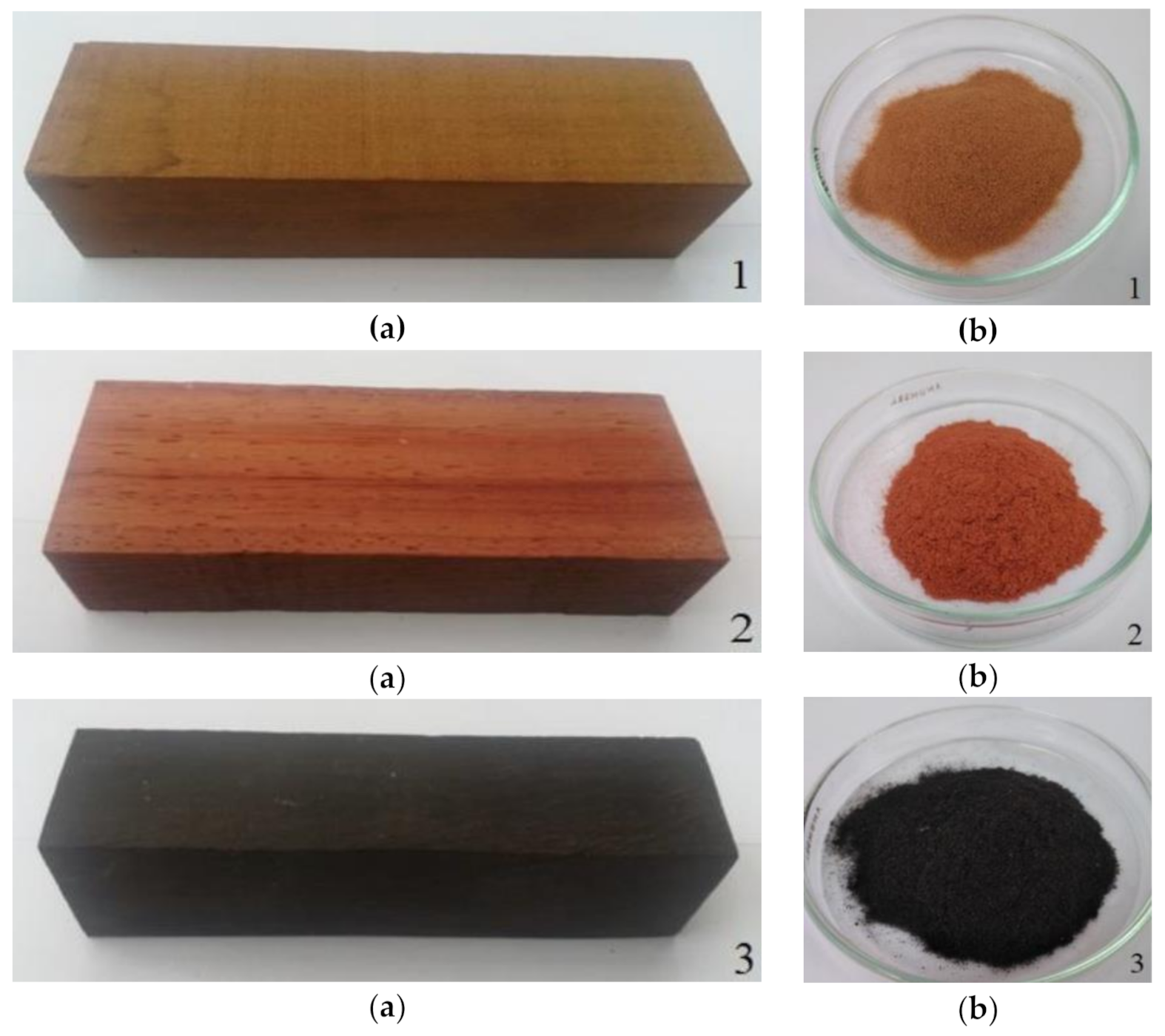

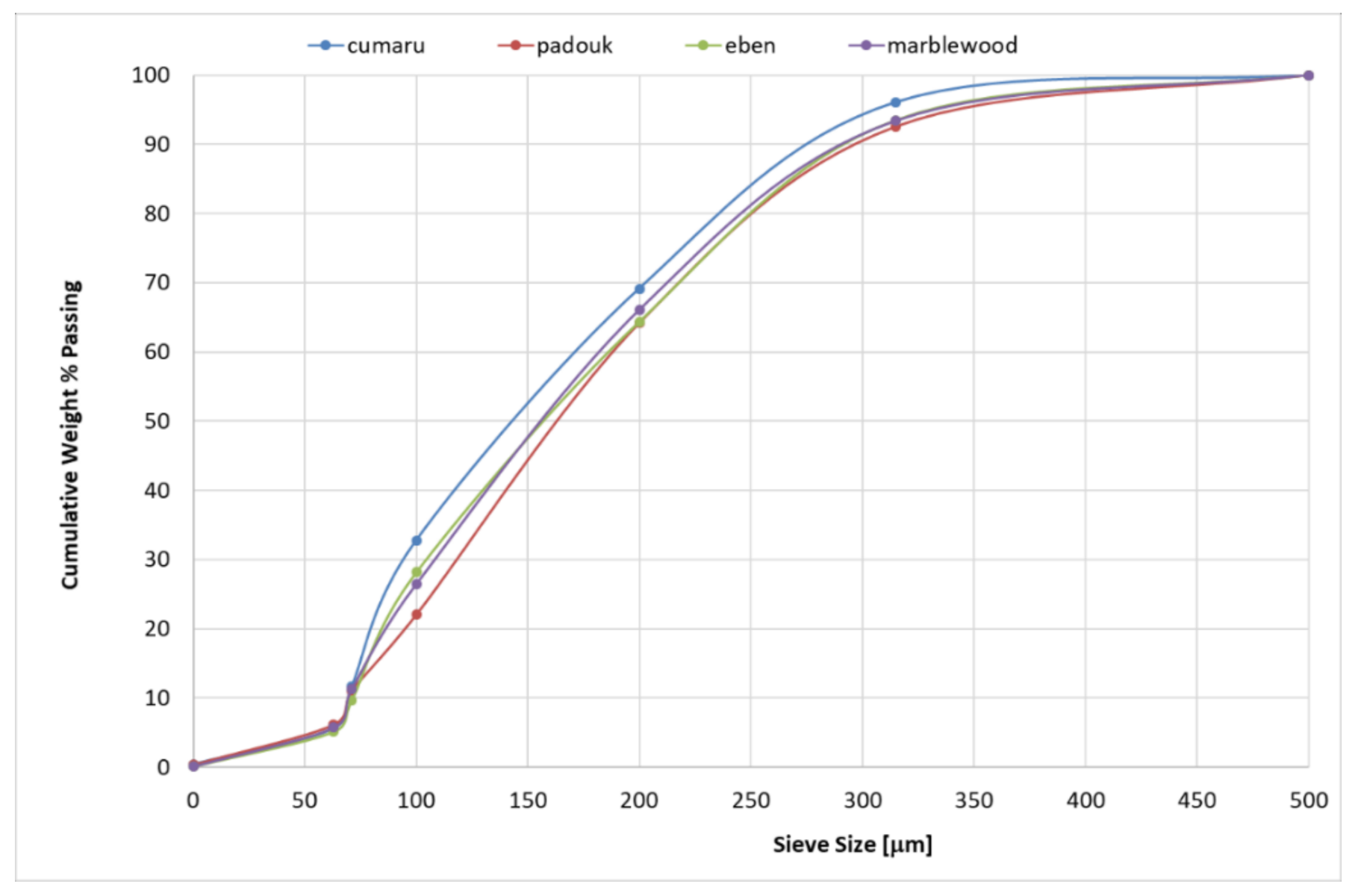

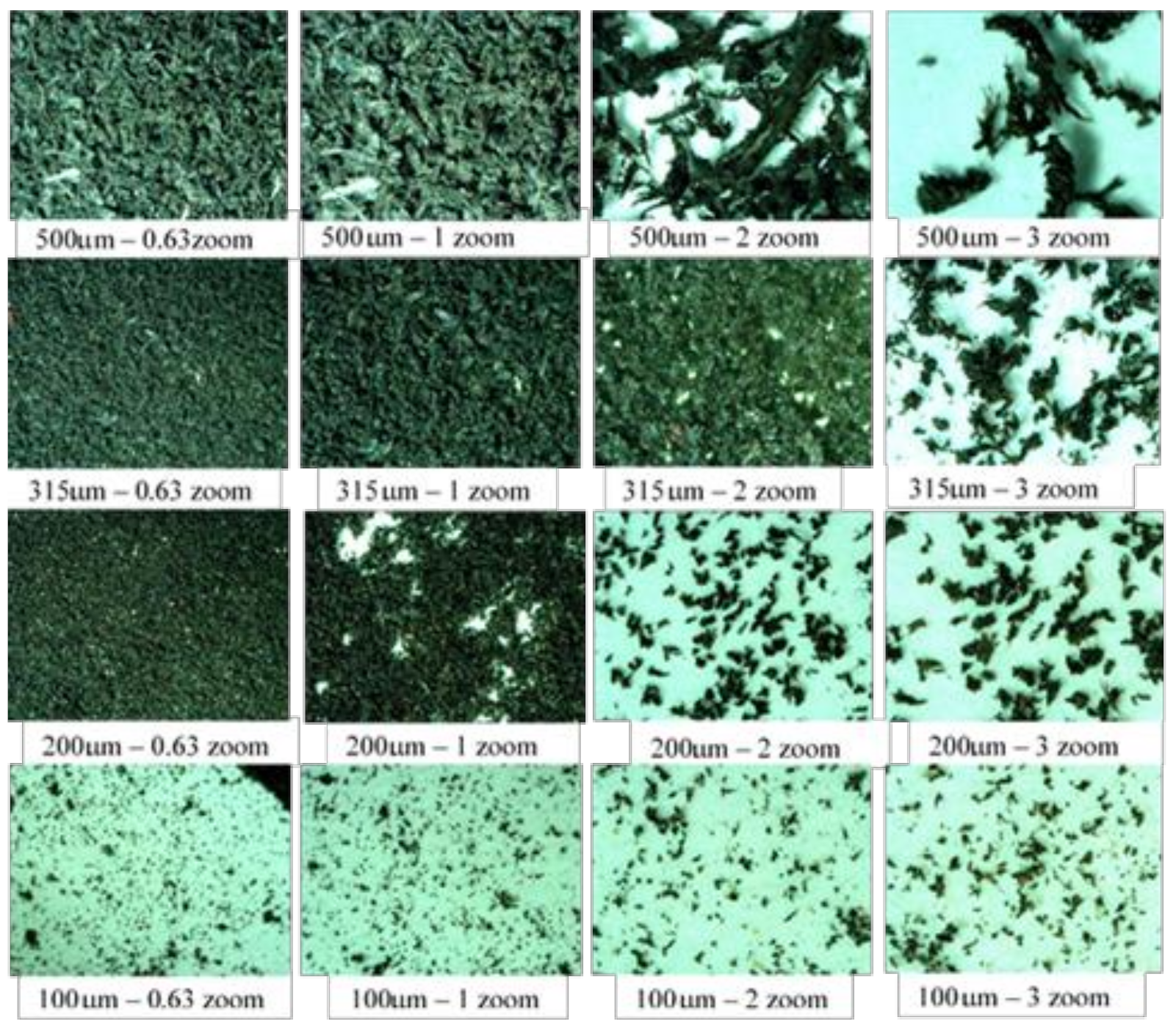

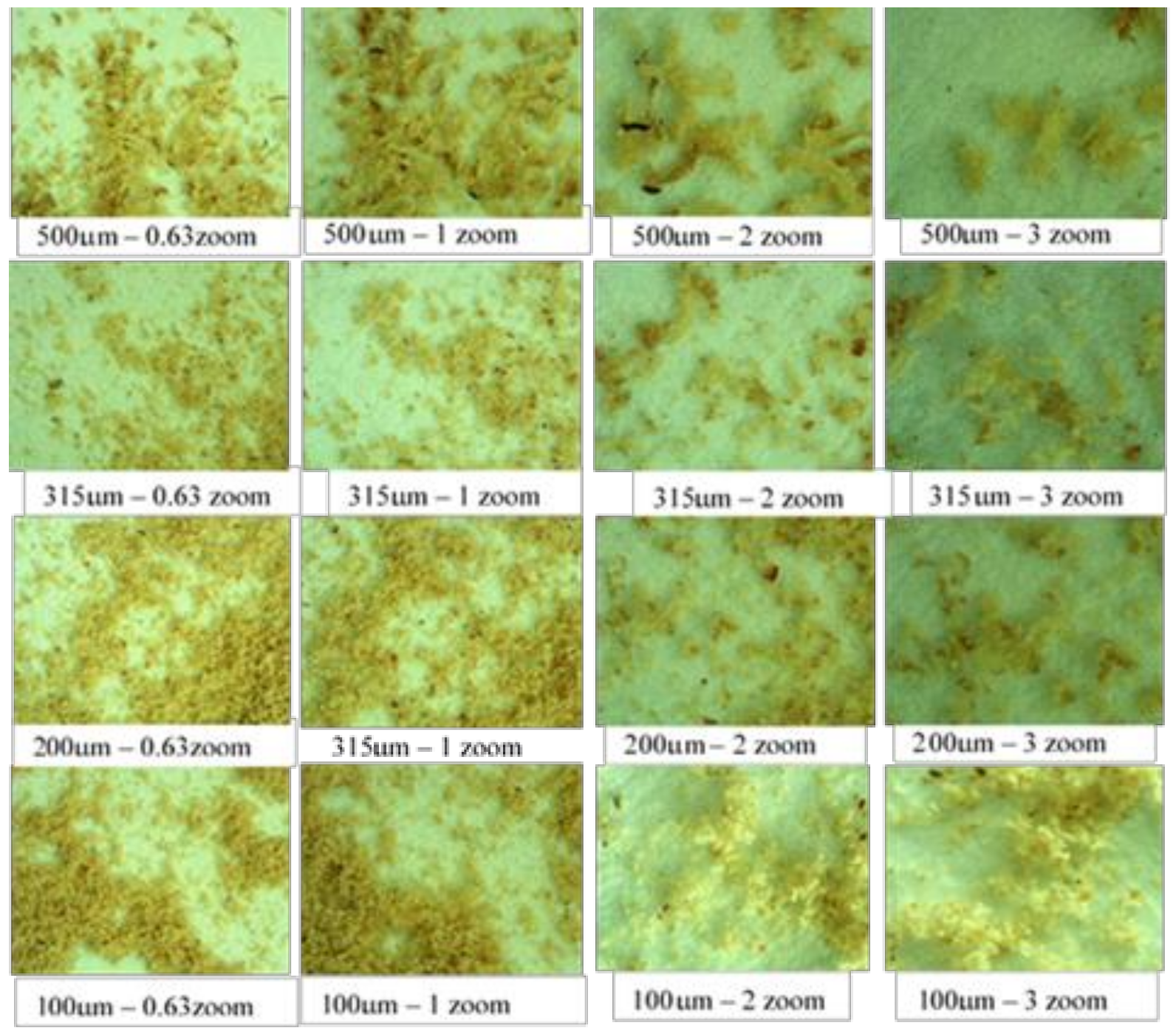
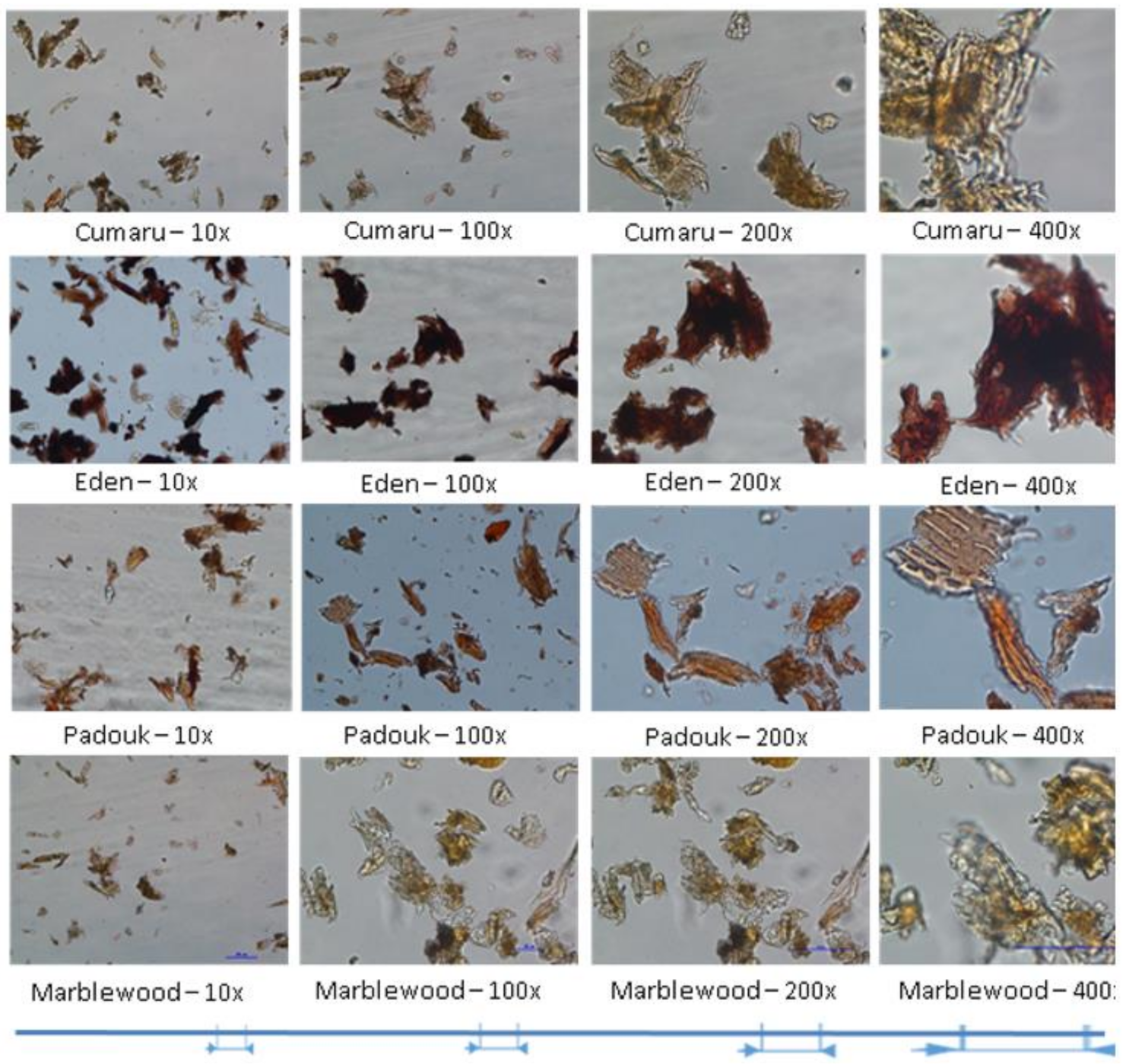

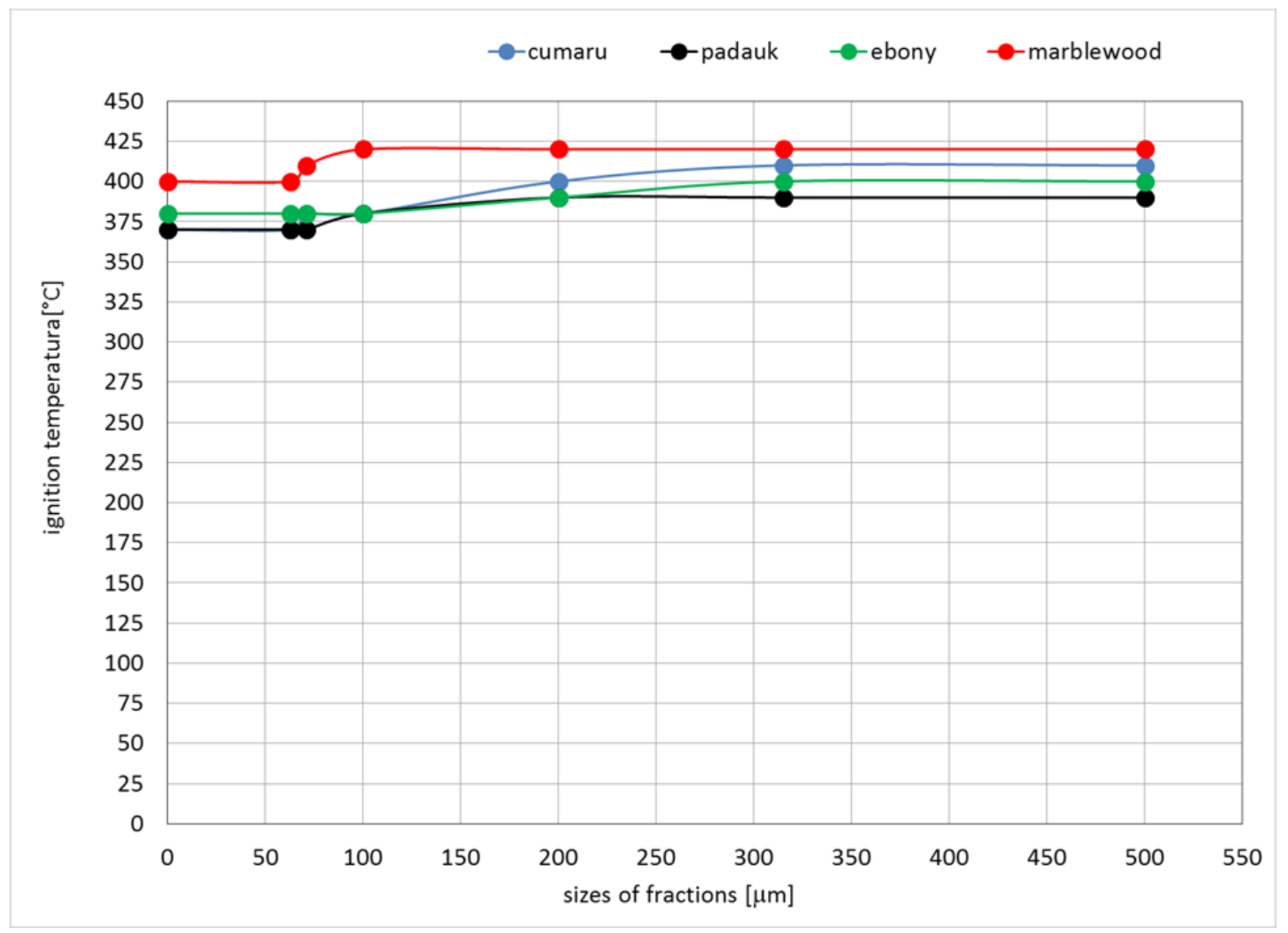
| Common Name 1 | Scientific Name | Density (kg·m−3) |
|---|---|---|
| Cumaru | Dipteryx odorata | 1075.69 ± 10.04 |
| Padauk | Pterocarpus soyauxii | 720.40 ± 9.52 |
| Ebony | Diospyros crassiflora | 960.00 ± 7.46 |
| Marblewood | Marmaroxylon racemosum | 1000.08 ± 9.98 |
| Tropical Dust Samples | Cumaru | Padauk | Ebony | Marblewood |
|---|---|---|---|---|
| Average bulk density (kg·m−3) | 190.3 ± 2.466 | 167.3 ± 4.355 | 206.5 ± 2.562 | 187.9 ± 8.535 |
| Dust moisture (%) | 5.93 ± 0.05 | 5.34 ± 0.08 | 4.83 ± 0.07 | 7.34 ± 0.1 |
| Fraction | % Particle Number | |||
|---|---|---|---|---|
| Size | Cumaru | Padauk | Ebony | Marblewood |
| 500 | 1.15 ± 0.076 | 1.55 ± 0.115 | 1.36 ± 0.275 | 1.26 ± 0.244 |
| 315 | 2.78 ± 0.745 | 6.29 ± 0.621 | 5.15 ± 0.537 | 5.33 ± 0.591 |
| 200 | 26.92 ± 0.779 | 28.37 ± 0.547 | 29.12 ± 0.464 | 27.31 ± 0.462 |
| 100 | 36.37 ± 1.2018 | 42.14 ± 1.049 | 36.21 ± 1.126 | 39.61 ± 0.367 |
| 71 | 21.14 ± 0.875 | 10.97 ± 1.453 | 18.56 ± 0.180 | 15.22 ± 0.111 |
| 63 | 6.07 ± 0.591 | 4.92 ± 0.312 | 4.44 ± 0.858 | 5.5 ± 0.383 |
| <63 | 5.18 ± 0.495 | 5.81 ± 0.399 | 5.04 ± 0.420 | 5.64 ± 0.612 |
Publisher’s Note: MDPI stays neutral with regard to jurisdictional claims in published maps and institutional affiliations. |
© 2020 by the authors. Licensee MDPI, Basel, Switzerland. This article is an open access article distributed under the terms and conditions of the Creative Commons Attribution (CC BY) license (http://creativecommons.org/licenses/by/4.0/).
Share and Cite
Vandličková, M.; Marková, I.; Makovická Osvaldová, L.; Gašpercová, S.; Svetlík, J.; Vraniak, J. Tropical Wood Dusts—Granulometry, Morfology and Ignition Temperature. Appl. Sci. 2020, 10, 7608. https://doi.org/10.3390/app10217608
Vandličková M, Marková I, Makovická Osvaldová L, Gašpercová S, Svetlík J, Vraniak J. Tropical Wood Dusts—Granulometry, Morfology and Ignition Temperature. Applied Sciences. 2020; 10(21):7608. https://doi.org/10.3390/app10217608
Chicago/Turabian StyleVandličková, Miroslava, Iveta Marková, Linda Makovická Osvaldová, Stanislava Gašpercová, Jozef Svetlík, and Jozef Vraniak. 2020. "Tropical Wood Dusts—Granulometry, Morfology and Ignition Temperature" Applied Sciences 10, no. 21: 7608. https://doi.org/10.3390/app10217608
APA StyleVandličková, M., Marková, I., Makovická Osvaldová, L., Gašpercová, S., Svetlík, J., & Vraniak, J. (2020). Tropical Wood Dusts—Granulometry, Morfology and Ignition Temperature. Applied Sciences, 10(21), 7608. https://doi.org/10.3390/app10217608






